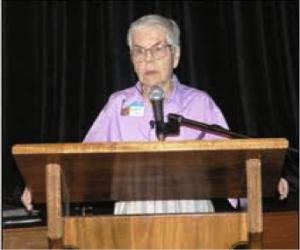Educator and applied linguist, Courtney Cazden, offered the first significant scholarship on classroom language, in her critical examination of the dynamics of teacher and student talk.

Several features of education institutions make communication so central. First, spoken language is the medium by which much teaching takes place, and in which students demonstrate to teachers much of what they have learned … .
Second, classrooms are among the most crowded of human environments. Few adults spend as many hours per day in such crowded conditions. Classrooms are similar in this respect to restaurants and buses or subways. But in such places simultaneous conversations are normal, whereas in classrooms one person, the teacher, is responsible for controlling all the talk that occurs while class is officially in session—controlling not just negatively, as a traffic officer does to avoid collisions, but also positively, to enhance the purposes of education.
Third, and perhaps least obviously, spoken language is an important part of the identities of all the participants. Variation in ways of speaking is a universal fact of social life. Schools are the first large institution to which children come from their families and home neighborhoods, and in which they are expected to participate individually and publicly (in contrast, for example, to simply sitting and standing at appropriate times and joining in prayers and songs in church). Especially during the period of school consolidation and desegregation, and the continuing migration across state and national borders, classrooms usually include people—adults and children—from different linguistic backgrounds.
Differences in how something is said, and even when, can be matters of only temporary adjustment, or they can seriously impair effective teaching and accurate evaluation. For all these reasons, it is essential to consider the classroom communication system as a problematic medium that cannot be ignored, or viewed as transparent, by anyone interested in teaching and learning. …
Classroom discourse happens among students and teacher. But arguably the most important goal of education is change within each student that we call learning. How do the words spoken in classrooms affect this learning? How does the observable classroom discourse affect the unobservable thinking of each of the students, and thereby the nature of what they learn? In the words of Douglas Barnes, written twenty-five years ago and quoted in the introduction to this book’s first edition, how does speech unite the cognitive and the social? In the more recent words of anthropologist Barbara Rogoff, how can we best understand relationships among three “planes of analysis” of any event: individual development, social interaction, and the cultural activities in which both take place?’
It is never easy to talk about relationships between individual (silent) thinking processes and the dyadic or group (often noisy) interactions in the classroom. But because that relationship is at the heart of student learning and must therefore be at the heart of teachers’ planning, we have to try. …
Creating the conditions for the interdependent goals of academic and language development for all students requires changes in classroom language use … . It’s a big job, and teachers can’t make these changes alone. Contexts are nested, from the most immediate to the act of speaking to the more distant: classroom, school, district, and so on. Plus, the classroom context is never wholly of the participants’ making.’ Bracketing out such influences … and considering classroom discourse as if it were autonomous, is expedient for teachers and researchers. But those who help to shape the contexts that surround the classroom have to realize their responsibility as well.
Some teachers will want to take on the added work of trying to influence policies that affect their work. That’s where teacher research comes in. In addition to refining education in their own classrooms, teachers’ research can contribute local evidence to discussions about educational policies in their schools and districts. That evidence, like the evidence from text or personal experiences provided by student speakers, makes teachers’ statements in such forums “accountable” too?
Finally, a word from one teacher to others. Thinking about the research reported [here] inevitably will lead to greater self-consciousness, at least temporarily. It has for me, when teaching in San Diego and since, and I wish it didn’t have to happen. I wish we as teachers could be as successful as so many parents on intuition alone. But as anthropologist Edward Sapir explains: “It is sometimes necessary to become conscious of the forms of social behavior in order to bring about a more serviceable adaptation to changing conditions.” Or, in his blunter words, analysis and conscious control are “the medicine of society, not its food.”
Because of conditions both within the classroom and outside it, we need the “medicine” of more careful analysis and conscious control so that our implicit theories of the language of teaching and learning can be open to continual re-vision. Nothing less does justice to our profession and our children.
Cazden, Courtney. Classroom Discourse: The Language of Teaching and Learning. Portsmouth, New Hampshire: Heinemann, 2001, pp. 2-3, 60, 181. || Amazon || WorldCat
